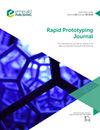Inconel-625的增材制造:从粉末生产到批量样品打印
IF 3.6
4区 工程技术
Q1 ENGINEERING, MECHANICAL
引用次数: 0
摘要
目的对于金属增材制造,金属粉末通常通过真空诱导气体雾化(VIGA)通过气体射流将液态金属分解成微小的液滴来生产。VIGA被认为是一种具有成本效益的原料制备技术。在VIGA中,产生的颗粒的质量和形态主要由粉末生产过程中使用的气体压力控制,保持设置配置不变。设计/方法/方法在金属增材制造原料制备的VIGA工艺中,粉末颗粒的质量和形态主要由粉末生产过程中使用的气体压力控制。发现在本研究中,Inconel-625原料是在紧密耦合的气体雾化装置中使用超音速喷嘴生产的。通过改变气体压力来研究粉末粒度分布。原创性/价值在气体压力和PSD之间观察到非单调但确定性的关系。研究发现,最大15–45 μm百分比PSD,相当于84%,在29 bar氩气压力,适用于LPBF工艺。随后,使用激光功率=475W,激光扫描速度=800,通过LPBF沿XY和ZX方向将制备的粉末颗粒用于打印拉伸试样 mm/s,粉末层厚度=50 µm,舱口距离=100 µm。屈服强度和拉伸强度分别比ZX方向高9.45%和13%,而在ZX方向印刷的样品的伸长率比XY方向高26.79%。本文章由计算机程序翻译,如有差异,请以英文原文为准。
Additive manufacturing of Inconel-625: from powder production to bulk samples printing
Purpose
For metal additive manufacturing, metallic powders are usually produced by vacuum induction gas atomization (VIGA) through the breakup of liquid metal into tiny droplets by gas jets. VIGA is considered a cost-effective technique to prepare feedstock. In VIGA, the quality and the morphology of the produced particles are mainly controlled by the gas pressure used during powder production, keeping the setup configuration constant.
Design/methodology/approach
In VIGA process for metallic additive manufacturing feedstock preparation, the quality and morphology of the powder particles are mainly controlled by the gas pressure used during powder production.
Findings
In this study, Inconel-625 feedstock was produced using a supersonic nozzle in a close-coupled gas atomization apparatus. Powder size distribution (PSD) was studied by varying the gas pressure.
Originality/value
The nonmonotonic but deterministic relationships were observed between gas pressure and PSD. It was found that the maximum 15–45 µm percentage PSD, equivalent to 84%, was achieved at 29 bar Argon gas pressure, which is suitable for the LPBF process. Following on, the produced powder particles were used to print tensile test specimens via LPBF along XY- and ZX-orientations by using laser power = 475 W, laser scanning speed = 800 mm/s, powder layer thickness = 50 µm and hatch distance = 100 µm. The yield and tensile strengths were 9.45% and 13% higher than the ZX direction, while the samples printed in ZX direction resulted in 26.79% more elongation compared to XY-orientation.
求助全文
通过发布文献求助,成功后即可免费获取论文全文。
去求助
来源期刊

Rapid Prototyping Journal
工程技术-材料科学:综合
CiteScore
8.30
自引率
10.30%
发文量
137
审稿时长
4.6 months
期刊介绍:
Rapid Prototyping Journal concentrates on development in a manufacturing environment but covers applications in other areas, such as medicine and construction. All papers published in this field are scattered over a wide range of international publications, none of which actually specializes in this particular discipline, this journal is a vital resource for anyone involved in additive manufacturing. It draws together important refereed papers on all aspects of AM from distinguished sources all over the world, to give a truly international perspective on this dynamic and exciting area.
-Benchmarking – certification and qualification in AM-
Mass customisation in AM-
Design for AM-
Materials aspects-
Reviews of processes/applications-
CAD and other software aspects-
Enhancement of existing processes-
Integration with design process-
Management implications-
New AM processes-
Novel applications of AM parts-
AM for tooling-
Medical applications-
Reverse engineering in relation to AM-
Additive & Subtractive hybrid manufacturing-
Industrialisation
 求助内容:
求助内容: 应助结果提醒方式:
应助结果提醒方式:


